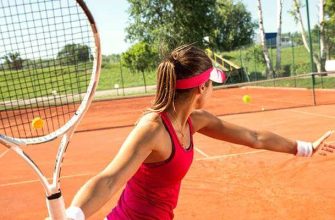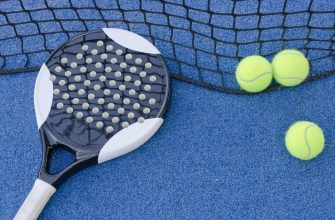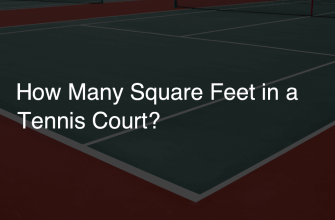Playing tennis is a great way to stay active and healthy. It provides cardiovascular benefits, improves hand-eye coordination and agility, and helps develop strategic thinking. While nothing can fully replace playing on a court, practicing tennis at home is a convenient and effective way to improve your skills between lessons or matches. Practicing at home allows you to work on your strokes, footwork, and consistency without having to commute to a court.
It also gives you the flexibility to train on your own schedule. With some space, basic equipment, creativity and dedication, you can keep your tennis game sharp no matter where you are. This guide will cover how to optimize your home environment, the essential gear to have, drills to practice, ways to make training engaging, and more.
By following these tips for at-home training, you can boost your confidence and tennis abilities.
Assess Your Space
The minimum suggested dimensions for a regulation tennis court are 60 feet wide by 120 feet long, totaling 7,200 square feet of space. However, you can practice tennis strokes and drills at home in a much smaller area. The most important factors are having enough room to comfortably swing your racquet, and move side to side and front to back during hitting.
For a beginner practicing groundstrokes alone, aim for at least a 20 feet wide by 40 feet long section of flat space. This allows room to take 2-3 steps back from the hitting point, and space to run up to short balls. Advanced players will want more room to work with. When hitting against a wall at home, stand 10-20 feet away for casual practice.
But competitive players may want to stand 30-40 feet away to simulate realistic court positioning. Measure out your available backyard, driveway, patio space and see what drills you can adapt to fit. Having 20 x 20 feet of open area already gives you some solid options.
Get the Right Equipment

When practicing tennis at home, having the right equipment is essential for an effective training session. Here are some of the key pieces of equipment you’ll want to have:
Racket
Your racket is the most important piece of equipment. Be sure to use a racket you are comfortable with and appropriate for your skill level. It’s a good idea to have 2-3 rackets in case restringing is needed.
Balls
Invest in a case of new balls specifically designed for practice. Pressureless balls are ideal, as they have less bounce for practicing strokes close to the net or against a backboard/wall.
Net or Backboard
Setting up a practice net or using a backboard or sturdy wall is key for practicing serves, groundstrokes, and volleys. A net can allow for more realistic practice, while a backboard is useful for repetitive solo hitting.
Make sure you have all the essentials covered – having the proper equipment will maximize the effectiveness of your at-home training sessions. Investing in quality gear tailored for practice purposes is well worth it.
Practice Your Strokes
There are many fun and useful drills for practicing forehands, backhands, serving, and volleys at home without a court. Here are some great options:
Forehands: The speed bounce drill involves bouncing a ball as fast as you can while taking a forehand swing. This builds racket speed and consistency. You can also practice forehand targets by placing objects around a room or hallway and aiming for them. Hitting against a practice wall allows working on form.
Backhands: Similar to forehands, backhand target practice entails placing items around the space to aim for. The two-bounce drill develops backhand groundstrokes by hitting a ball after it bounces twice. Hitting against a wall aids technique.
Serves: Toss a ball and practice the full serving motion without hitting it. Work on precise ball tosses and smooth strokes. Aim to develop consistency in your timing and technique. Can also hit gently against a practice wall.
Volleys: Drop a ball and take a split step before volleying it, concentrating on quick reaction time. Bounce a ball and as it comes up, volley it back down. Have someone gently toss balls while you work on volleys.
Practicing all these strokes repeatedly develops muscle memory. Make sure to build in recovery time as you would on court. Recording videos for review aids improvement as well.
Work on Footwork

Proper footwork is essential for being in the right position to hit strong and accurate shots in tennis.
Here are some footwork drills you can do at home to improve your movement on the court:
-
Grapevines: Stand in a neutral ready position. Step sideways by crossing one foot behind the other, then step the other way crossing your feet again. Keep alternating to move side to side while keeping your upper body steady and facing forward. Do 20-30 reps each way.
-
T-drills: Set up objects on the ground in a T shape (or use tape to mark spots). Start at the base, shuffle sideways to touch the left spot, shuffle back to base, then right spot and back. Work on controlled sideways shuffling and changing directions.
-
Short sprints: Set up cones or objects to sprint to and from. Practice quick 10-15 yard sprints forward, backpedaling, and side to side. Focus on exploding from ready position.
-
Reaction drills: Have someone call out or toss balls left, right, forward, and back. React by sprinting to touch the ball, then recover back. Work on quick reaction time from ready position.
-
Lunges: Take big lunge steps side to side or forward and back across the room. Focus on pushing off the lead foot powerfully. Keep your body upright and head still.
The key is incorporating footwork into dynamic drills that improve agility, speed, balance, and coordination required on the tennis court. Train your feet to react quickly and move efficiently.
Train Your Consistency
One of the best ways to improve your tennis game at home is by training to be more consistent with your shots. Consistency allows you to stay in rallies longer and reduce unforced errors. When playing at home, set up targets or markers to aim for. Focus on hitting the same spots over and over.
Work on hitting different types of shots – forehand, backhand, volleys, overhead smashes – with precision and control. Pick a small target zone and keep aiming for it. Over time, your accuracy will improve dramatically. You can use items like cones, chalk markings, empty cans or cardboard boxes as targets.
Also, try repetition drills. Hit 20 balls in a row to a target. Then move to a different spot and repeat. See how many quality shots you can hit before missing the target. This engages muscle memory so you can groove proper stroke mechanics. Another useful solo drill is to hit balls against a backboard or wall and work on returning them consistently to the same area.
This simulates the repetition of a long rally. Focus on fundamentals like preparation, footwork, timing, and follow through. Record yourself to check for errors. With regular consistency training at home, you’ll develop solid groundstrokes and gain confidence in your shots.
Play Against a Wall
One of the best ways to practice tennis shots at home is to hit against a wall. A wall provides a consistent surface to hit against and allows you to work on stroke technique and consistency.
When hitting against a wall:
-
Set up targets with chalk or tape to aim for. This will help improve your accuracy.
-
Alternate between forehands and backhands. Make sure to hit with proper form and technique.
-
Move around and hit shots from different positions and distances. This improves footwork.
-
Vary the speed and spin on your shots. Hitting different types of shots will increase versatility.
-
Practice specific drills like cross-court groundstrokes or approach shots. Isolating drills builds skills.
-
Imagine you are playing points. React quickly to “returns” and recover properly.
-
Maintain proper ready position and court coverage. Move your feet like you would in a real match.
For the best results, make sure to take breaks and stay hydrated when practicing for long periods against a wall. Keep sessions fun by setting challenges or targets. Wall practice is extremely effective for developing solid tennis fundamentals. As expert Andy Roddick says, “The best players spent thousands of hours against a wall as kids.”
Record Your Sessions

Video recording yourself hitting or serving is one of the most useful training techniques you can do at home. Being able to watch video of your strokes and serves gives you the chance to objectively analyze your form and technique. Often when we are playing, it can feel like we are hitting the ball correctly, but by recording and watching video we may notice technical mistakes that we were not aware of before.
Some key benefits of recording yourself include:
- Seeing if your ready position and footwork are correct before you hit the ball
- Checking that you are using proper technique on groundstrokes, volleys, and serves
- Identifying any unnecessary motion or tension in your stroke production
- Noticing if you are consistent in your technique or have flaws that appear occasionally
- Keeping track of your improvement over time as you fix technical issues
Make sure to record yourself from both the front and side view when possible. Setting your camera or phone on a tripod, fence, or stationary object will provide you with the best angle. Play out points or hit through a basket of balls, then watch the video back and take notes on areas you can improve. Don’t get frustrated if you spot flaws, just use it as motivation to continue perfecting your strokes. Recording yourself regularly will accelerate your learning.
Make It Fun
Adding enjoyment to your at-home tennis practice will help build your skills while keeping you engaged.
Some ways to make practicing fun include:
-
Set up target cones or objects to aim for when hitting serves or groundstrokes. Seeing if you can hit specific targets helps improve control.
-
Play “Around the World” by hitting shots to different areas of the court and moving around to the next position after each shot. This improves footwork and shot consistency.
-
Try trick shots like between-the-legs or behind-the-back. Challenging yourself with creative shots makes practice exciting.
-
Design various tennis games and point scoring systems to play against the wall. Using your imagination keeps things lively.
-
Track stats like targets hit, consecutive volleys, or aces to challenge yourself. Statistics motivate improvement.
-
Play music, take breaks for water, or switch drills every 10 minutes. Good pace prevents boredom.
-
Record videos of yourself to check form or share progress on social media. Adding a multimedia element leverages technology.
-
Invite friends or family members to join in on the fun, even if they don’t play tennis! Social involvement makes practice enjoyable.
Adding some creativity, competition, and multimedia to your solo tennis sessions at home makes skill-building more rewarding and sustainable. Don’t let practicing alone mean practicing bored!
Conclusion
Overall, practicing tennis at home can be a fun, engaging way to improve your skills while getting in a good workout. With some basic equipment, space, and a little creativity, you can work on all aspects of your game right in your own backyard or driveway.
The main benefits of at-home practice include:
- Improving your stroke technique by repeating drills and swing motion
- Developing better footwork, speed, and agility through footwork patterns
- Building consistency by practicing repetition
- Getting a cardiovascular workout to boost endurance
- Staying motivated by tracking progress and mixing up routines
- Avoiding court fees and commute time to hit anytime at home
At-home training combined with playing on a court can help take your tennis skills to the next level. By implementing some of the tips in this guide, you’ll be rallying like a pro in no time!








